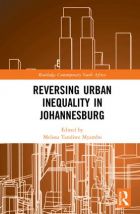Reversing Urban Inequality in Johannesburg

Reversing Urban Inequality in Johannesburg investigates the ways that neoliberal urban policy produces sociospatial inequality in South Africa’s largest city. Johannesburg is a site of particular interest because of its historic legacy of apartheid and the resultant inequalities, and its contemporary post-apartheid commitment to redressing and ameliorating these inequalities.
Johannesburg’s urban policy demonstrates the priorities of a modern developmental state (i.e. a socially inclusive, safe, healthy, affordable and equitable city), in line with UN Habitat’s new urban paradigm. However, these priorities conflict with the trend towards spatial and income inequality defining the city’s landscape. Thus, the book considers whether Johannesburg can create a more accessible, equitable and liveable city with more democratic public transport, affordable housing in desirable locations, and public spaces that are safe and socially and racially integrated.
Chapters were contributed by academics and professionals from a broad range of disciplinary backgrounds, including urban planning, anthropology, political economy, architecture and social development. They grew out of a seminar at the Johannesburg Institute for Advanced Studies titled “What is spatial transformation? Possibilities for a more equitable, liveable Johannesburg”. The chapters are organized into five parts: (1) government programmes’ unexpected consequences; (2) effects of private capital; (3) architectural and urban design; (4) apartheid’s unintended consequences; and (5) global capitalism and local government.
The volume’s editor, Melissa Tandiwe Myambo, contributed a chapter entitled “Red velvet cheesecake in Maboneng, Pap and Steak in Jeppestown: displacement and global hipsterification in downtown Jozi” (Chapter 6). Describing the phenomenon of “global hipsterification”, Myambo explores how the recently established Maboneng area represents the successful physical and ideological annexation of city space through the process of global hipsterification, according to an ethos that both masks and justifies the displacement of lower-income residents. Officially a part of Jeppestown, Maboneng was rebranded by Jonathan Liebmann, a private developer who is largely responsible for the gentrification of the area. However, Liebmann denies that Maboneng’s urban renewal embodies gentrification’s dynamic of displacement.
In contrast, Myambo argues that the hipster ethos that includes progressive social values of inclusion often diverges significantly from the reality produced by hipster practice (page 73):
“while hipsters sip artisan coffee in trendy Maboneng, residents from low-rent flats in abandoned buildings in nearby Jeppestown protest against planned evictions that will make way for further gentrification in the area”.
Thus, Maboneng is a microcosm of the way spatial inequality is systematically reproduced in Johannesburg, and it exemplifies a new type of globalized gentrification emerging in the 21st century – one that differs in aesthetics, urban design and ethos, but produces the same consequences for the less privileged.
Book note prepared by Kate Goh
Search the Book notes database
Our Book notes database contains details and summaries of all the publications included in Book notes since 1993 - with details on how to obtain/download.
Use the search form above, or visit the Book notes landing page for more options and latest content.
For a searchable database for papers in Environment and Urbanization, go to http://eau.sagepub.com/

